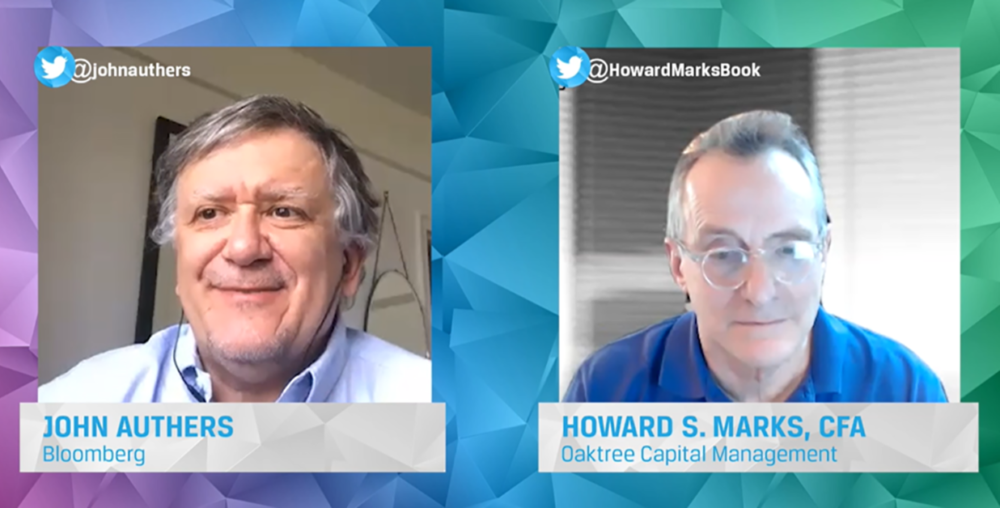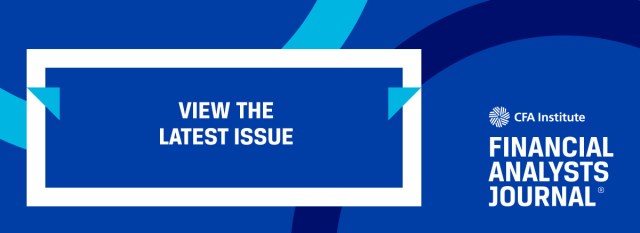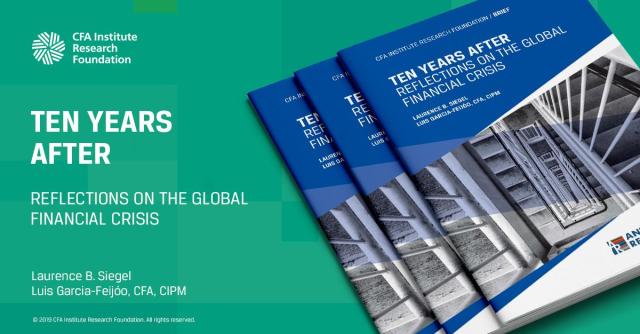[ad_1]
“No amount of sophistication is going to allay the fact that all of your knowledge is about the past and all your decisions are about the future.” — Howard Marks, CFA
Oaktree Capital Management co-chair Howard Marks, CFA, sat down with Bloomberg senior editor John Authers at the 73rd CFA Institute Annual Virtual Conference and offered an illuminating glimpse into the thought processes that have driven his decades-long career in high-yield fixed-income markets.
Two patterns stand out: Being different and being right.
“Superior investing has to come from correct idiosyncratic decisions,” Marks explained. “You have to depart from what they’re doing for a reason.”
He went on to highlight six insights that have helped frame his investment philosophy.
1. View Market Movements Constructively
Investors tend to perceive market activity through the prism of boom-and-bust cycles and anticipate future movements based on past patterns. “The cycle, generally speaking,” Marks explained, “is a series of up and down oscillations around a central trend line.”
But the conventional terms that describe these market movements — boom and bust, up and down — carry connotations that can influence an investor’s perspective and create a distortive effect. So Marks avoids them.
“I tend to think of them, more productively, as excesses and corrections,” he said.
2. Know What You Don’t Know
The importance of intellectual humility, of being aware that there are limits to your knowledge, was a recurring theme in Marks and Authers’s conversation.
The current financial crisis, in particular, serves as a vivid case in point. Since its principal cause — a global health pandemic — is without recent precedent or parallel, investment expertise and market experience that might inform the response to, say, a conventional asset bubble or debt crisis are of little to no use.
“It’s so silly for an investor to build his investment conclusions around his view of what the disease holds when he knows nothing about it,” Marks said. “You shouldn’t make it up on your own, you should look to the experts.”
3. Insist on a Margin of Safety
The margin of safety is a key concept among value investors searching for undervalued securities. “For any given investment that you consider making, you evaluate the investment relative to the underlying fundamentals,” Marks said.
To define the margin of safety for a particular investment, Marks recommends investors consider the company, the stability of the industry, and the underlying predictability of both as well as the lowness of the price.
“The expert calibrates the expression of his opinion based on how firm the evidence is,” Marks said. “The investor should calibrate his confidence in his investment based on how much margin of safety there is.”
4. Know When to Get Aggressive
Oaktree tends to be circumspect about its investments. “Normally, we take a very cautious approach to our risk asset classes,” Marks said.
That’s the concession they make to what they don’t know, and for investors, caution is always appropriate when dealing with the unknown.
Nevertheless, Marks and Oaktree aren’t afraid to get aggressive when they believe they’ve identified good investments. “I think that toggling between aggressive and defensive is the greatest single thing that an investor can do,” he said. “If they can do it appropriately.”
5. Be Different, But Be Correct
Following the market does not lead to outperformance.
To generate better investment returns you have to separate yourself from the herd. And you have to be right.
“If you think and behave different from other people — and you’re more right than they are, that’s a necessary ingredient — then you can have superior performance,” Marks said.
The approach may sound simple. But it’s much more difficult in practice. Rejecting the consensus is an easy reflex, but in investing, that consensus — the market — is right more often not.
“Knee-jerk contrarianism is certainly not a successful strategy,” he said.
6. Get Comfortable with Discomfort
“Every great investment begins in discomfort,” Marks explained. “If everyone else didn’t hate the investments, they wouldn’t be cheap.”
Asset prices drop when nobody wants to buy them. So the investments with the largest margin of safety or the largest gap between their current selling price and their intrinsic value can be the most unwanted. Holding unwanted assets can be uncomfortable.
The challenge comes when the discomfort endures for a long time. Yet investment decisions are rarely validated on the day they are made.
“Many times, it doesn’t work for months, or maybe years,” Marks said. “One of the most important adages in our business is that being too far ahead of your time is indistinguishable from being wrong. And that’s where the discomfort comes from.”
As the world struggles with the global pandemic and its associated financial crisis, Marks believes uncertainty and discomfort will be major components of financial markets for the foreseeable future. The toll of the disease and the economic impact of fighting it will last for a long time.
“This will play out over the next several quarters, if not years,” Marks said.
If you liked this post, don’t forget to subscribe to the Enterprising Investor.
All posts are the opinion of the author. As such, they should not be construed as investment advice, nor do the opinions expressed necessarily reflect the views of CFA Institute or the author’s employer.
Professional Learning for CFA Institute Members
CFA Institute members are empowered to self-determine and self-report professional learning (PL) credits earned, including content on Enterprising Investor. Members can record credits easily using their online PL tracker.
[ad_2]
Image and article originally from blogs.cfainstitute.org. Read the original article here.



